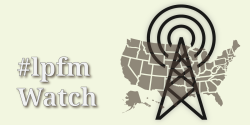Five new low-power FM stations have been granted their full licenses in the last week:
- KQRZ-LP, Oregon Amateur Radio Club (Hillsboro, OR)
- WTPB-LP, Third Presbyterian Church of Rockford (Rockford, IL)
- WEMV-LP, Elijah Message Ministry (Vandalia, IL)
- KMYB-LP, Killeen Independent School District (Killeen, TX)
- WBNH-LP, Town of Bedford, NH
LPFMs Mostly Unaffected by New Performance Royalty Rates
I’ve been reporting on the threat that new performance royalty fees are presenting to small and medium-sized internet radio stations. In light of the news that many webcasters are shutting down because they can’t afford the much higher rates, some LPFM stations have been wondering if their web streams will be impacted as well.
It should come as a relief to LPFMs that these particular new rates only apply to so-called pure-play internet stations. That is, stations which only broadcast online, with no terrestrial signal, that also are not operated by a tax-exempt non-profit or government entity.
Noncommercial radio stations, including low-power stations, are able to elect fees based upon the noncommercial webcaster rates set by the Copyright Royalty Board. I won’t get into the details–the SoundExchange website is a good place to find them–but the most important aspect is that most LPFMs likely qualify to make just the minimum payment of $500 a year per stream. There are additional fees for popular stations with large listenerships of more than 159,140 aggregate tuning hours a month, which is roughly equivalent to having an average of 221 simultaneous online listeners every hour in a 30-day month.
However, the recent shutdown of Live365–partially due to the new performance royalties–has affected a number of LPFMs which relied upon the service for their streams. Those stations can continue webcasting, though they will have to find new streaming services. If they were using Live365 to cover their royalty payments, then they will have to begin paying and reporting to SoundExchange directly.
The change for 2016 that most impacts low-power stations is the loss of the reporting waiver for all stations not owned by a school or college. Internet broadcasters are required to send SoundExchange reports of every song played on the stream. Previous to this year small noncommercial stations were able to pay a $100 annual fee to obtain a waiver from this requirement, which now no longer exists. Now many LPFMs are required to make these reports on a quarterly basis, which certainly increases the labor needed to maintain a web stream. This is an area where a playlist application or service–like Spinitron–can come in handy.
College and school-owned stations are still able to elect the reporting waiver.
While LPFMs and other noncommercial terrestrial stations are not experiencing the same pressure as pure-play webcasters, I encourage staff and volunteers at terrestrial stations to pay attention to this situation. Many small internet stations effectively operate as noncommercial stations, broadcasting to serve specific communities and niches, with little revenue or profit.
The loss of these small internet radio stations is a blow to internet radio diversity and also threatens to raise the bar for innovation online in a way that is very much like terrestrial radio before LPFM was created in 2000. At the end of the last century there were diminishing opportunities for new community stations, such that in most urban markets it was impossible to find an open frequency, and it would require millions in capital to buy an existing noncommercial license.
In the US we may be facing a situation where it will require millions to start up and sustain a new internet station if it isn’t owned by a school, government agency or IRS recognized 501(c)(3) nonprofit. Note that the standard to qualify for noncommercial royalty rates as an internet station is more stringent than for a terrestrial station. LPFMs, for instance, need only to be incorporated as non-profits at the state level–they do not have to IRS recognized tax-exempt charities.
I hope community radio folks everywhere can see how this is a time when solidarity across the terrestrial/internet divide may be necessary.



